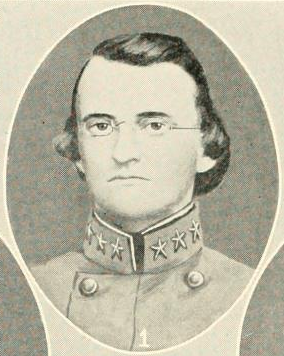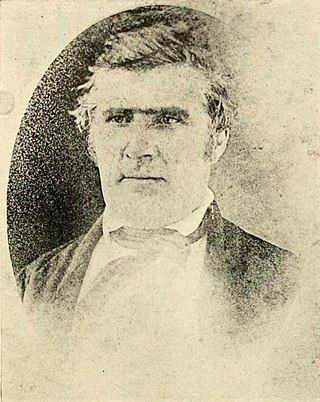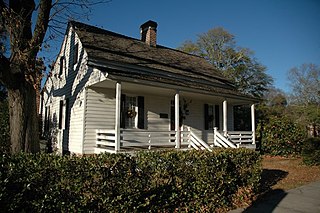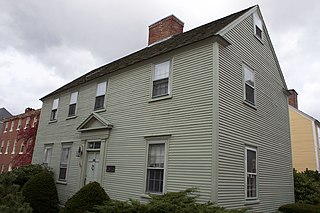
Stovall is a town in Granville County, North Carolina, United States. The population was 418 as of the 2010 census.

Sion Hart Rogers was a U.S. Congressman and Attorney General of North Carolina.

This is a list of structures, sites, districts, and objects on the National Register of Historic Places in North Carolina:

Alfred Dockery was an American Congressional Representative from North Carolina.

The Orton Plantation is a historic plantation house in the Smithville Township of Brunswick County, North Carolina, United States. Located beside the Cape Fear River between Wilmington and Southport, Orton Plantation is considered to be a near-perfect example of Southern antebellum architecture. Built in 1735 by the co-founder of Brunswick Town, Colonel Maurice Moore, the Orton Plantation house is one of the oldest structures in Brunswick County. During its history Orton Plantation has been attacked by Native Americans, used as a military hospital, and been home to lawyers, physicians, military leaders, and a Colonial governor.
John Hart House or John L. Hart House may refer to:

John L. Hart House in Hartsville, South Carolina, also known as Hart-Mills Cottage, was built in 1850. It was listed on the National Register of Historic Places in 1983. It is located in the East Home Avenue Historic District.

This list includes properties and districts listed on the National Register of Historic Places in Wilkes County, North Carolina. Click the "Map of all coordinates" link to the right to view an online map of all properties and districts with latitude and longitude coordinates in the table below.

This list includes properties and districts listed on the National Register of Historic Places in Caswell County, North Carolina. Click the "Map of all coordinates" link to the right to view an online map of all properties and districts with latitude and longitude coordinates in the table below.

This list includes properties and districts listed on the National Register of Historic Places in Robeson County, North Carolina. Click the "Map of all coordinates" link to the right to view a Google map of all properties and districts with latitude and longitude coordinates in the table below.

The Thomas E. Hart House and Kalmia Gardens is a 30-acre (12 ha) property in Hartsville, South Carolina, that was listed on the U.S. National Register of Historic Places in 1991. The house was built in 1817.

Halifax Historic District is a national historic district located at Halifax, Halifax County, North Carolina, US that was listed on the National Register of Historic Places in 1970. It includes several buildings that are individually listed on the National Register. Halifax was the site of the signing of the Halifax Resolves on April 12, 1776, a set of resolutions of the North Carolina Provincial Congress which led to the United States Declaration of Independence gaining the support of North Carolina's delegates to the Second Continental Congress in that year.

The Jeremiah Hart House is a historic house at The Hill in Portsmouth, New Hampshire. Probably built in the late 18th century, it is a well-preserved example of a late Georgian urban residential structure. It was originally located on Deer Street, and was moved as part of a road widening project. It was listed on the National Register of Historic Places in 1972.

The Hart-Rice House is a historic house at 408 The Hill in Portsmouth, New Hampshire. It is located on The Hill, a cluster of closely spaced historic buildings southeast of Deer Street, some of which were moved to the site as part of a road widening project. Built sometime between 1749 and 1756, it is a little-altered example of Georgian architecture with only modest Federal period alterations. It was listed on the National Register of Historic Places in 1972.
Bell-Sherrod House is a historic home located at Enfield, Halifax County, North Carolina. It was built about 1859, and is a two-story, rectangular, Italianate-style frame dwelling, with a Greek Revival-style front porch. It has a shingled hip roof pierced by two interior chimneys and is sheathed in weatherboard. A conservatory was added about 1915. The house was restored about 1987.

Hoffman-Bowers-Josey-Riddick House is a historic home located at Scotland Neck, Halifax County, North Carolina. It was built in 1883, and is a 2+1⁄2-story, rectangular, frame dwelling with Stick Style / Eastlake movement design elements. It has a complex polychromed, slate roof gable roof; three-story central tower with hexagonal roof; and one-story rear ell. It features a front porch with sawn balustrade.
Dr. Franklin Hart Farm, also known as Hidden Path, is a historic home and farm and national historic district located near Drake, Nash County, North Carolina. It includes a collection of well-preserved mid-19th to early-20th century dwellings and farm outbuildings. The main house was built about 1845, and is a two-story, three-bay, single pile I-house with Federal / Greek Revival style design elements. The front facade features a two-tier portico carried by massive, unusual turned and banded columns. Also on the property are the contributing detached kitchen building, smokehouse, seven tobacco barns, corn crib, mule barn, packhouse, and seven tenant houses. The Hart family owned and farmed the land from about 1770 until 1979.

Hawkins-Hartness House is a historic house in Raleigh, North Carolina. It was built around 1880 in the Eastlake style. It houses the office of the Lieutenant Governor of North Carolina.

Rogers-Bagley-Daniels-Pegues House is a historic home located at Raleigh, Wake County, North Carolina. It was built about 1855, and is a two-story, three bay by two bay, Greek Revival-style frame dwelling with a low hipped roof and Italianate-style accents. It has a hip roofed porch with Doric order posts and bay windows. It was built by Sion Hart Rogers (1825-1874), a Congressman from and Attorney General of North Carolina. It was the home of Josephus Daniels (1862-1948) from about 1894 to 1913.


















